By Baudilio Rebollo Fernández, Javier Corzo de Porras and Luis Montero de Espinosa
This year we decided to tour around Morocco during the second half of June, with the aim of finding a hotter and more stable climate at this time of the year, at least when speaking about the showers and rains in Spring. However, and as we all know, the climate is unpredictable mostly in a wider time span, so the scenario we found in as we got there was clearly not as we had thought of in the beginning.
[wpgmappity id=”4″]
Click on the map points to show locations.
Javier Corzo de Porras and I started our trip in Huelva heading Algeciras where we took a Ferry into Morocco. After typical procedures to go through the Strait of Gibraltar -as well as the Moroccan Customs- at 19 p.m. we were able to start our trip by car heading the South but with a non-defined destination, we would drive until night-time, which we estimated it would be near Casablanca.
During that night, of about 20ºC, we could observe some active specimens as: Mauritanian Toad (Amientoprhynus mauritanicus), the Dotted grainy Frog (Discoglossus Scovazzi), the Stripeless tree frog (Hyla meridionalis), a Horseshoe whip snake (Hemorrhois hippocrepis), a viperine snake (Natrix maura) which had been run over on the road and a great sized specimen of a Moorish viper (Daboia mauritanica), which we thought it had probably been hit during that afternoon, taking into account the state of the viper.
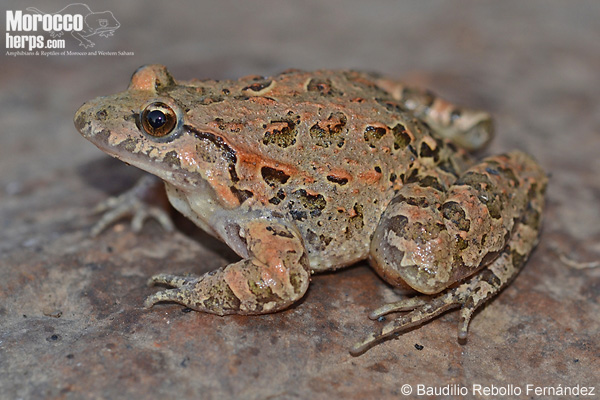
Dotted grainy frog (Discoglossus scovazii). Casablanca. Photo: © Baudilio Rebollo Fernández.
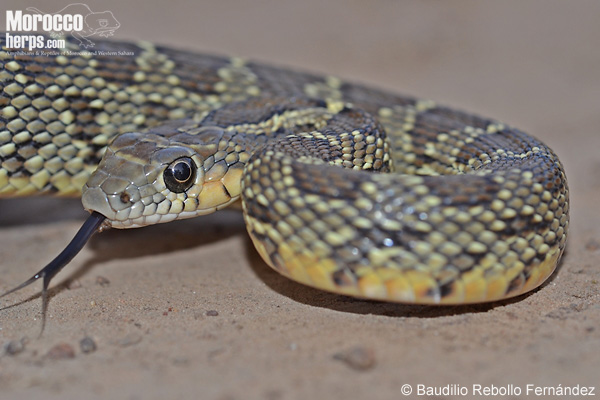
Horseshoe whip snake (Hemorrhois hippocrepis). Casablanca. Photo: © Baudilio Rebollo Fernández.
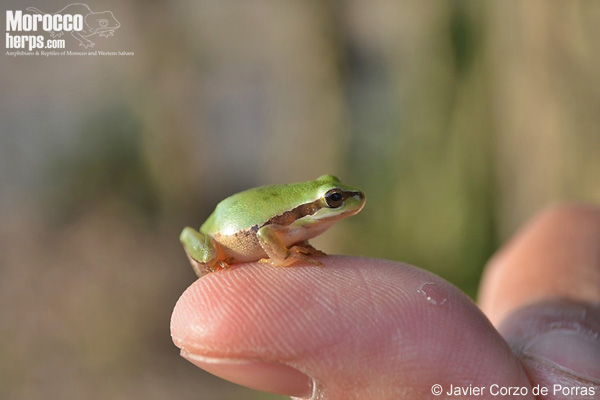
Juvenile Stripeless Tree Frog (Hyla meridionalis). Casablanca. Photo: © Javier Corzo de Porras.
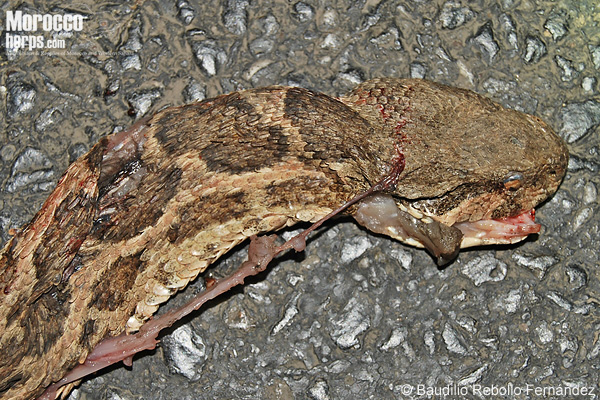
Great sized Daboia mauritanica specimen Death on road. Casablanca. Photo: © Baudilio Rebollo Fernández.
When we got up in Tiznit, we gathered around the place and we found some specimens as: a male Montpellier snake (Malpolon monspessulanus) measuring 1.64 m We found many specimens of Morocco Lizard-fingered Gecko (Saurodactylus brossetii), 4 Mediterranean Spur-thighed Tortoise (Testudo graeca), some Common Wall Geckos (Tarentola mauritanica) and a Bibron´s Agama (Agama impalearis).
Later on we headed for southern lands; our objective was to advance as much as we could that day to reach the south of Agadir, Tiznit, where we finally slept.
When we got up in Tiznit, we gathered around the place and we found some specimens as: a male Montpellier snake (Malpolon monspessulanus) measuring 1.64 m. We found many specimens of Morocco Lizard-fingered Gecko (Saurodactylus brosseti), 4 Mediterranean Spur-thighed Tortoise (Testudo graeca), some Common Wall Geckos (Tarentola mauritanica) and a Bibron´s Agama (Agama impalearis).
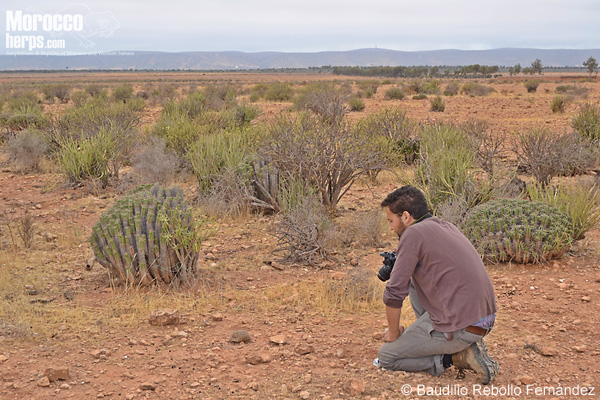
Javier taking pictures of a Mediterranean Spur-thighed Tortoise (Testudo graeca) in its habitat. Tiznit.
Photo: © Baudilio Rebollo Fernández.
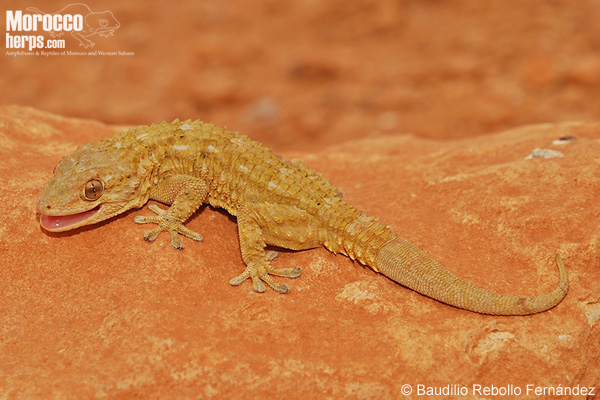
Common Wall Gecko (Tarentola mauritanica). Tiznit. Photo: © Baudilio Rebollo Fernández.
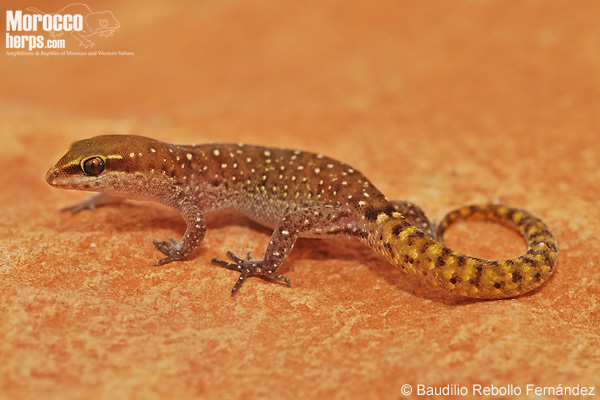
Morocco Lizard-fingered Gecko (Saurodactylus brosseti). Tiznit. Photo: © Baudilio Rebollo Fernández.
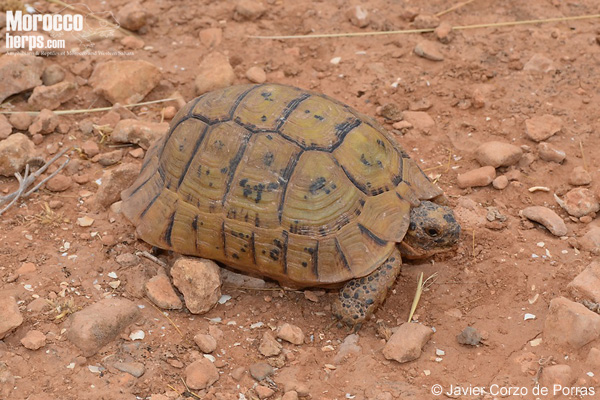
Mediterranean Spur-thighed Tortoise (Testudo graeca). Tiznit. Photo: © Javier Corzo de Porras.
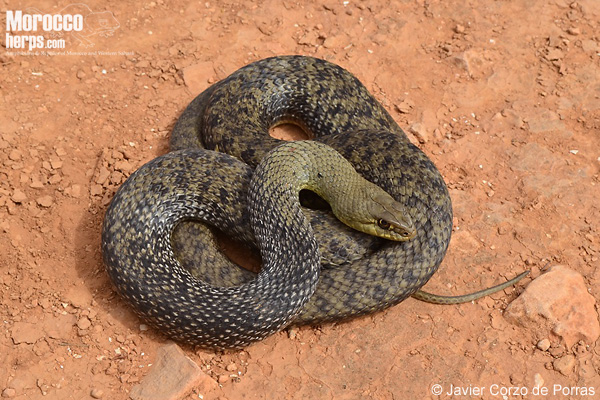
Montpellier Snake (Malpolon monspessulanus). Tiznit. Photo: © Javier Corzo de Porras.
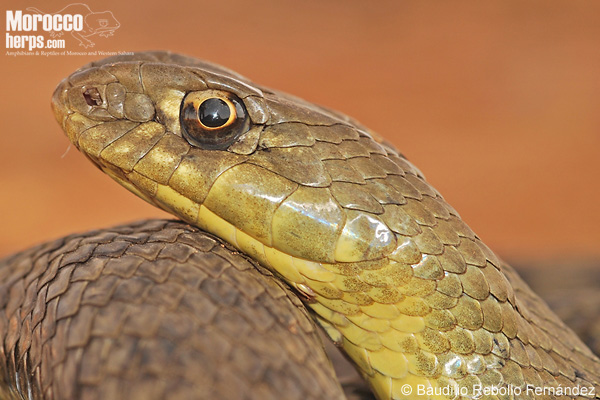
Detailed head of a huge Montpellier Snake. Tiznit.
Photo: © Baudilio Rebollo Fernández.
Heading for Sidi Ifni we explored different areas. As we approached coastal areas we found lower temperatures- as if it was going to pour with rain- even though the soil was quite dry and still the temperatures were high enough. We could find some specimens as: Bibron´s Agama (Agama impalearis), Sahara Frog (Pelophylax saharica), Mauritanian Toad (Amietoprhynus mauritanicus), Brongersma´s Toad (Barbarophryne brongersmai), and North African Green Toad (Bufotes boulengeri).
We observed that there is a wondrous activity and quantity of the insect called Eugaster sp.
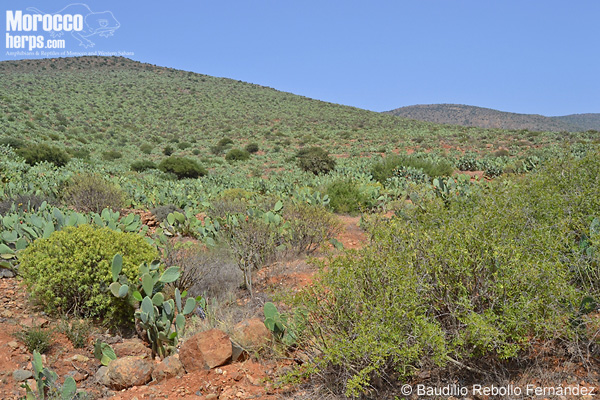
Habitat at Sidi Ifni. Photo: © Baudilio Rebollo Fernández.
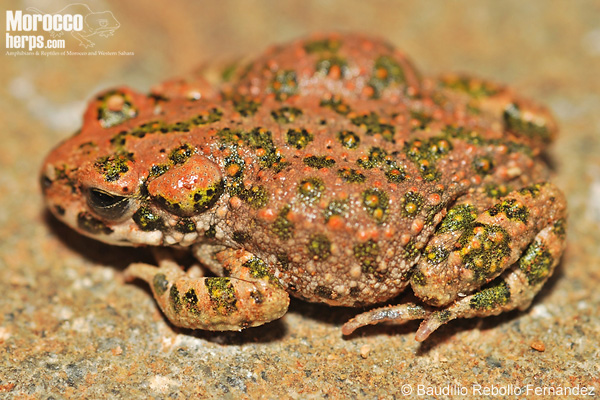
Brongersma´s Toad (Barbarophryne brongersmaii). Sidi Ifni. Photo: © Baudilio Rebollo Fernández.
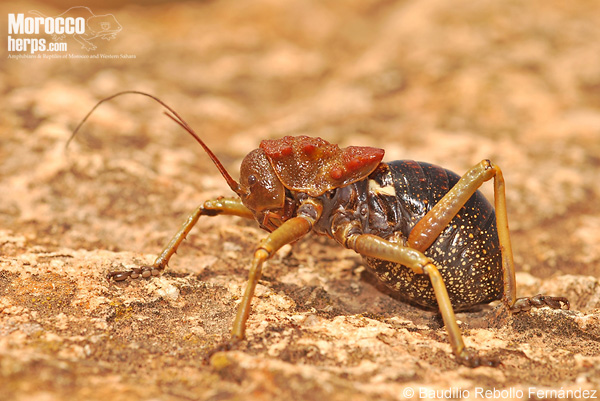
Eugaster sp. Sidi Ifni. Photo: © Baudilio Rebollo Fernández.
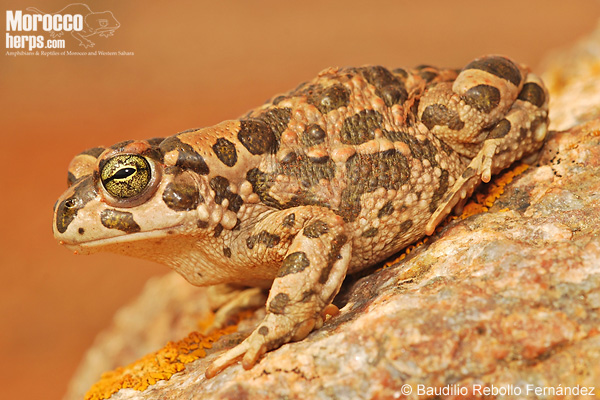
North African Green Toad (Bufotes boulengeri). Sidi Ifni. Photo: © Baudilio Rebollo Fernández.
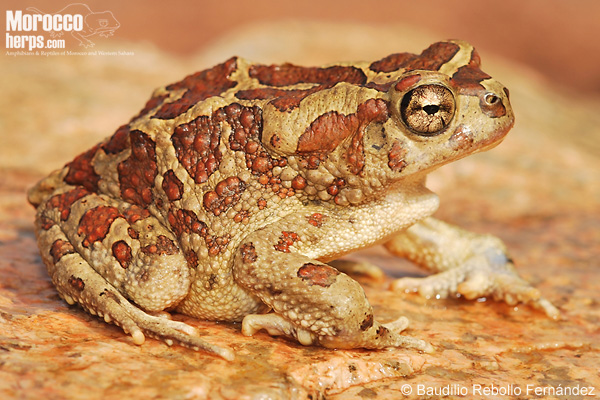
Mauritanian Toad (Amietoprhynus mauritanicus). Sidi Ifni. Photo: © Baudilio Rebollo Fernández.
During the next days, we carried out some researches along the coastal fringe going from Sidi Ifni to Tarfaya. We looked for some specimens that are found numerously on this area. However, the climate turned to be unusual, having day-temperatures under 21ºC, and windy nights pouring with rain with temperatures that dropped down to 8ºC- a climate we did not expect for that month of June on this area.
Despite the bizarreness of climate we were able to see the specimens we show below.
The Mograbin Diadem Snake (Spalerosophis dolichospilus), which had fallen into a pit and we were fortunate to rescue it, but unfortunately some meters away from there in another pit, we found a Moila Snake (Rhagerhis moilensis) which had been stoned to death. Given the state of the snake we estimated it had been there for two days, as ants and coleoptera had already started to feed from its softer parts, but the snake was still in one piece.
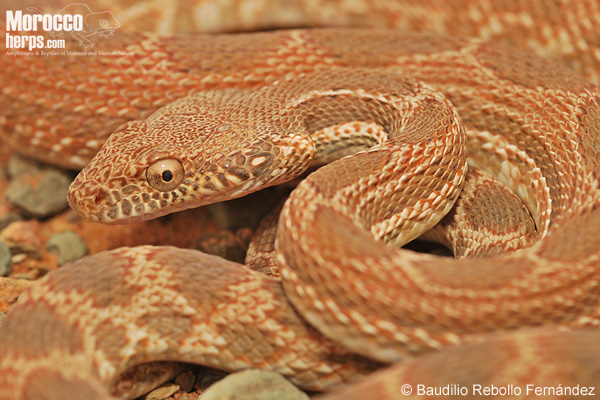
Mograbin Diadem Snake (Spalerosophis dolichospilus). Guelmim. Photo: © Baudilio Rebollo Fernández.
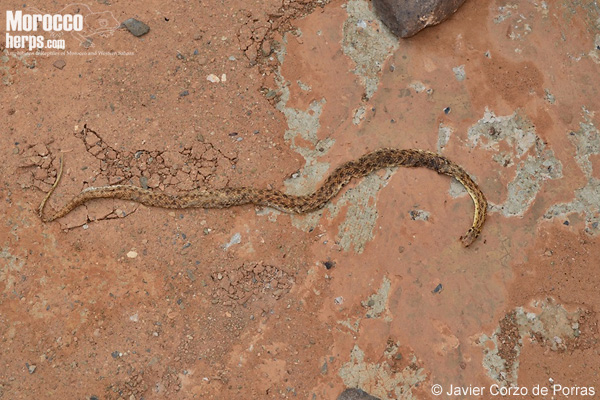
Moila Snake (Rhagerhis moilensis). Guelmim. Photo: © Javier Corzo de Porras.
We also found a Horseshoe Whip Snake (Hemorrhois sp.) which we wondered if it could be hybridized with an Algerian species, as apart from its bizarre color, it had an upper-labial scale directly contacted to its eye and 25 dorsal scales.
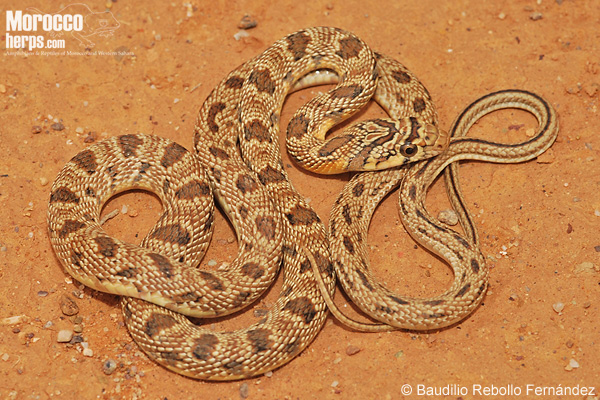
Hemorrhois sp. Guelmim. Photo: © Baudilio Rebollo Fernández.
During that day we also saw some other amphibians as Bosc´s Fringe-toed lizard (Acantodactylus boskianus), Northern Elegant Gecko (Stenodactylus mauritanicus), Morocco Lizard-fingered Gecko (Saurodactylus brossetii), Mauritanian Toad (Amietoprhynus mauritanicus), North African Green Toad (Bufotes boulengeri), and Bibron´s Agama (Agama impalearis).
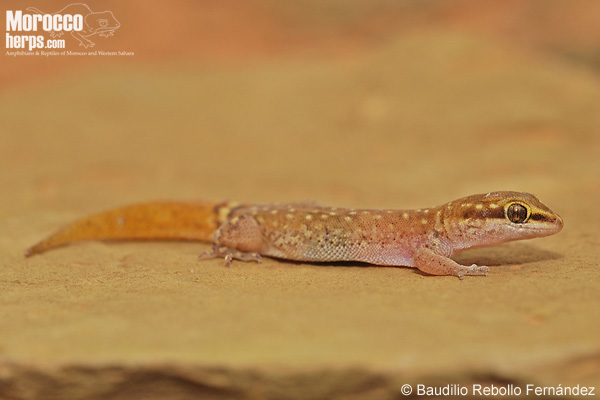
Morocco Lizard-fingered Gecko (Saurodactylus brosseti). Guelmim. Photo: © Baudilio Rebollo Fernández.
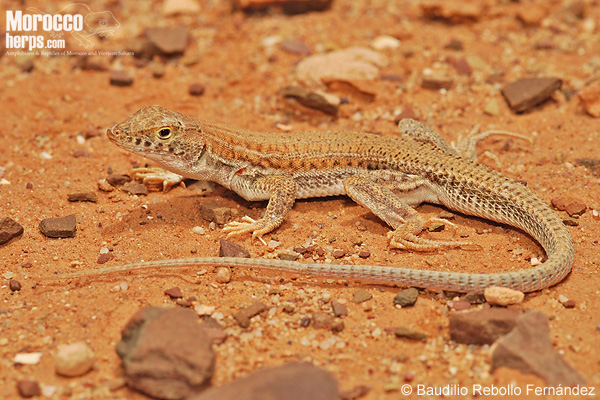
Acantodactylus boskianus. Guelmim. Photo: © Baudilio Rebollo Fernández.
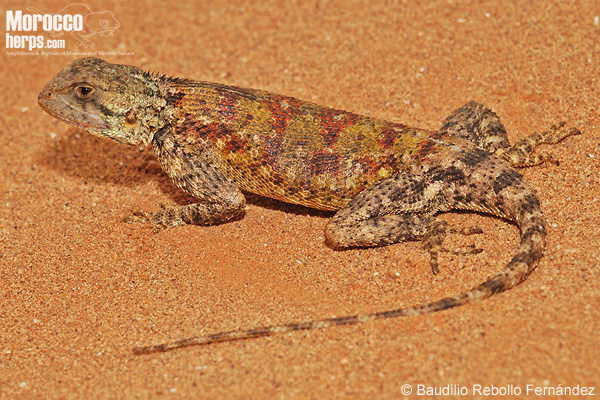
Bibron´s Agama (Agama impalearis). Guelmim. Photo: © Baudilio Rebollo Fernández.
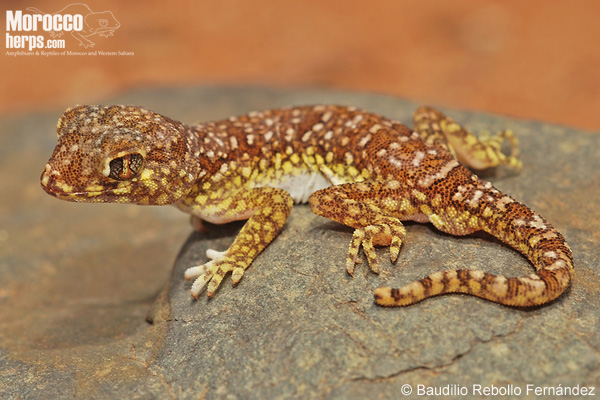
Northern Elegant Gecko (Stenodactylus mauritanicus). Guelmim. Photo: © Baudilio Rebollo Fernández.
After sleeping in a Hotel in Guelmin on Sunday 16th and recharging our batteries to keep going, we headed for Tarfaya, searching some interesting amphibians located on this area where we found some specimens of Bibron´s Agama (Agama impalearis), Mauritanian Toads (Amietoprhynus mauritanicus), Schokari Sand Racer or Bucerrig (Psammophis schockari), the beautiful Helmethead Gecko (Tarentola chazaliae), Duméril’s Wedge-snouted Skink (Chalcides sphenopsiformis).
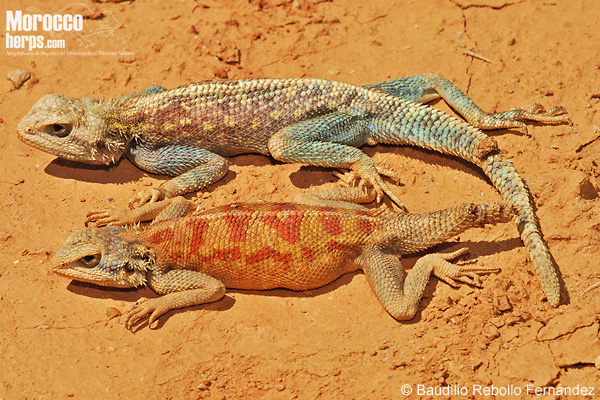
A couple of Bibron´s Agama (Agama impalearis) rescued from a waterhole.
We can observe the poor conditions of both due to starvation. Tan Tan.
Photo: © Baudilio Rebollo Fernández.
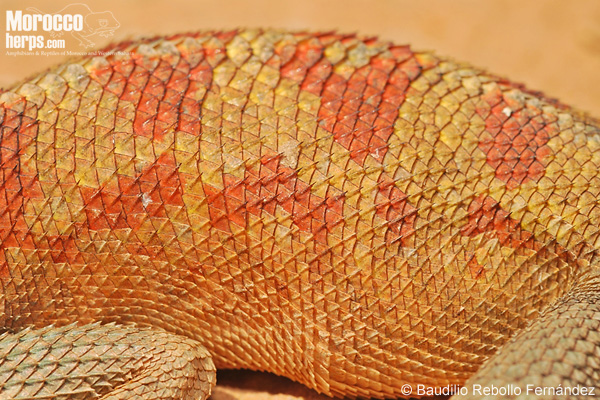
Female Agama (Agama impalearis) coloring details when pregnant.
Photo: © Baudilio Rebollo Fernández.
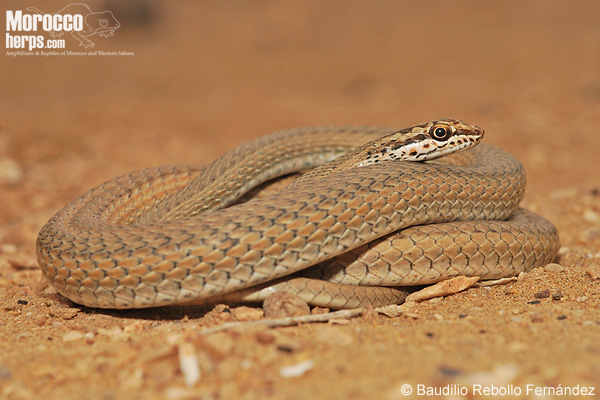
Great sized Bucerrig (Psammophis schockari). Tan Tan. Photo: © Baudilio Rebollo Fernández.
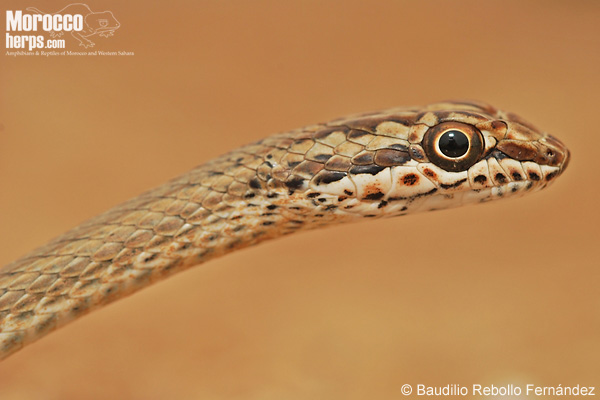
Bucerrig (Psammophis schockari) detailed head. Tan Tan. Photo: © Baudilio Rebollo Fernández.
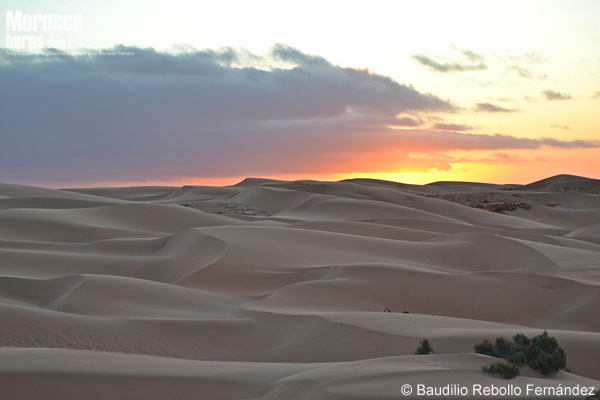
Habitat nearby Tarfaya. Photo: © Baudilio Rebollo Fernández.
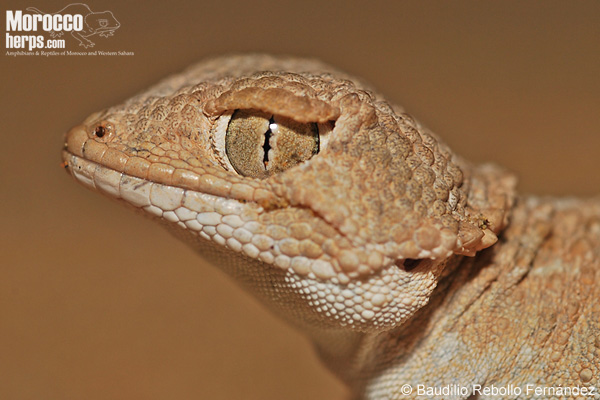
Head detail of Helmethead Gecko (Tarentola chazaliae). Tarfaya. Photo: © Baudilio Rebollo Fernández.
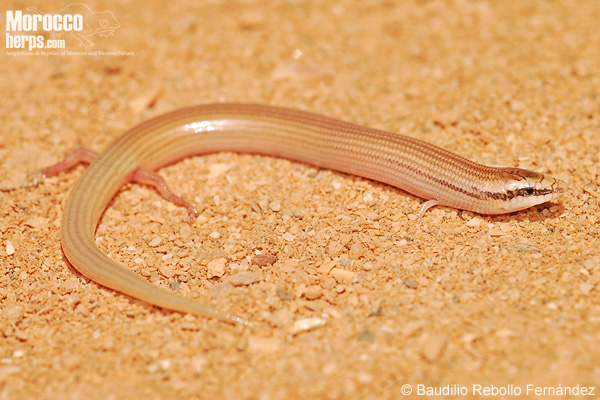
Duméril’s Wedge-snouted Skink (Chalcides sphenopsiformis). Tan Tan. Photo: © Baudilio Rebollo Fernández.
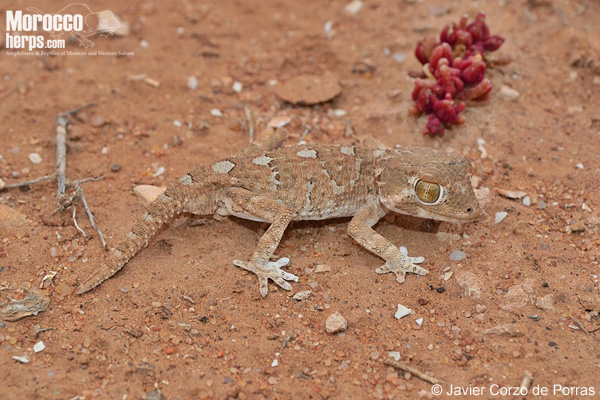
Helmethead Gecko in Tan Tan (Tarentola chazaliae). Photo: © Javier Corzo de Porras.
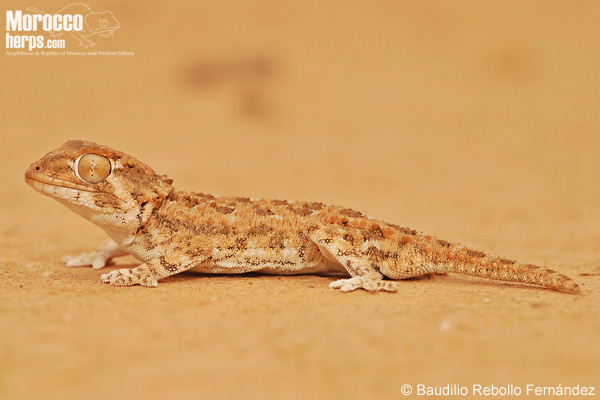
Another Helmethead Gecko (Tarentola chazaliae) in Tan Tan. Photo: © Baudilio Rebollo Fernández.
On the 21st and after several days around the area between Guelmin, Tan Tan and Tarfaya, we decided to go up to Marrakesh where we would pick up Luis Montero de Espinosa, with whom we would continue our route to inner areas, as climate at the coastal area was cold and unusual.
In our way back we decided to go into mainland and cross the Tafraoute argane reaching Taroudant. Later on we would cross the High Atlas through Tiz´n´Test to reach Asni and from there to Marrakesh. It took us several days due to the poor conditions of roads in the High Atlas.
We were able to see some amphibians during our way, mainly while being on the road. We could find some active amphibians along the roads during night time and daytime.
Near Tafraoute we found a pregnant female Bibron´s Agama. We also found two Horseshoe Whip Snakes (Hemorrhois hippocrepis), which had fallen down into a waterhole, and were extremely skinny and similar in size. We rescued both of them.
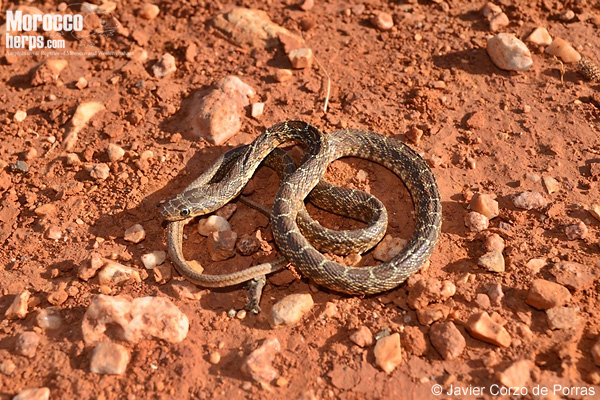
Horseshoe Whip Snake (Hemorrhois hippocrepis) rescued from a waterhole, which was in terrible conditions.
Tafroute. Photo: © Javier Corzo de Porras.
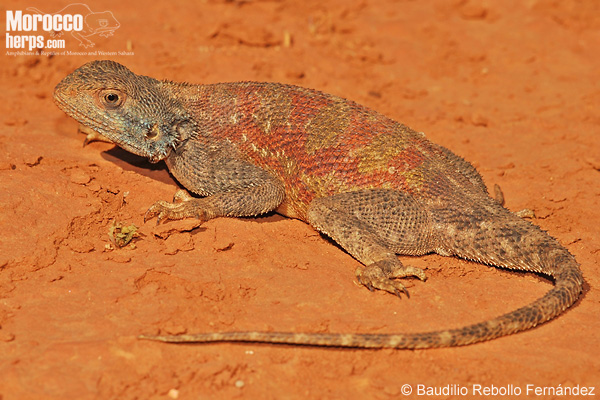
Pregnant Bibron´s Agama (Agama impalearis). Tafroute. Photo: © Baudilio Rebollo Fernández.
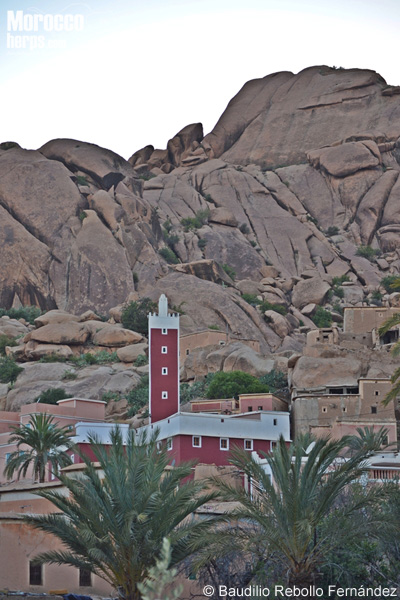
Tafroute. Photo: © Baudilio Rebollo Fernández.
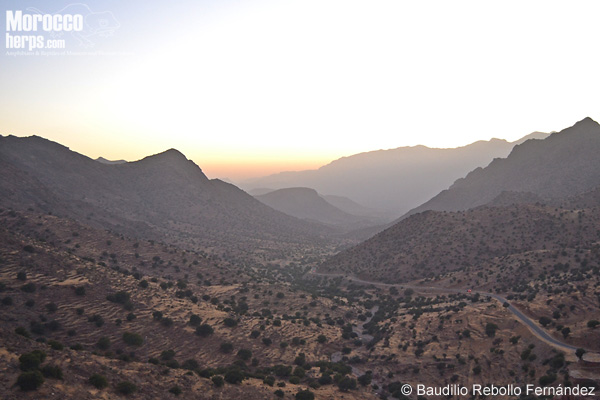
Sunset at Argan Forst near Tafraoute. Photo: © Baudilio Rebollo Fernández.
Getting nearer Taroudant, we found some specimens of Algerian Orange-tailed Skink (Eumeces algeriensis) we had not found in our trip yet.
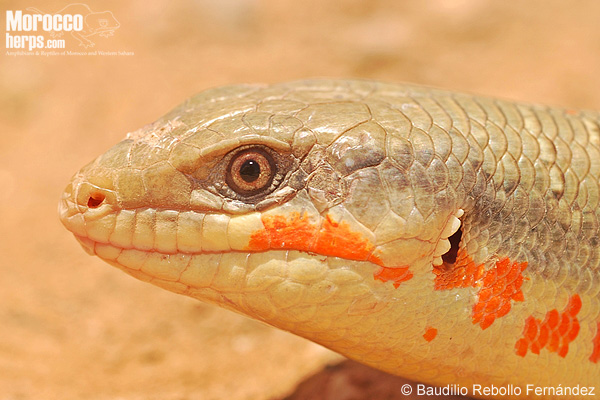
Algerian Orange-tailed Skink (Eumeces algeriensis) detailed head. Taroudant.
Photo: © Baudilio Rebollo Fernández.
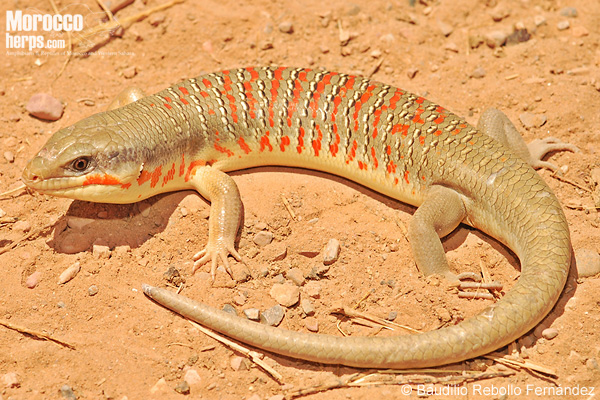
Algerian Orange-tailed Skink (Eumeces algeriensis). Taroudant. Photo: © Baudilio Rebollo Fernández.
We also found a Many-scaled Cylindrical Skink (Chalcides polylepis), and some Bibron´s Agama (Agama impalearis) nearby.
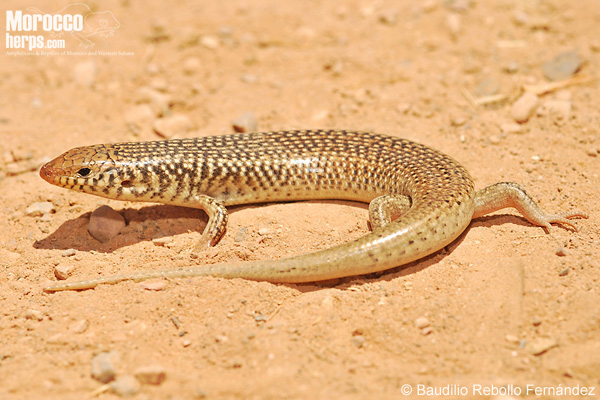
Many-scaled Cylindrical Skink (Chalcides polylepis). Taroudant. Photo: © Baudilio Rebollo Fernández.
Once on the road to Marrakesh passing by Tiz´n´Test and Asni- crossing the High Atlas, we found a beautiful Golden Fringe-fingered Lizard (Timon tingitanus).
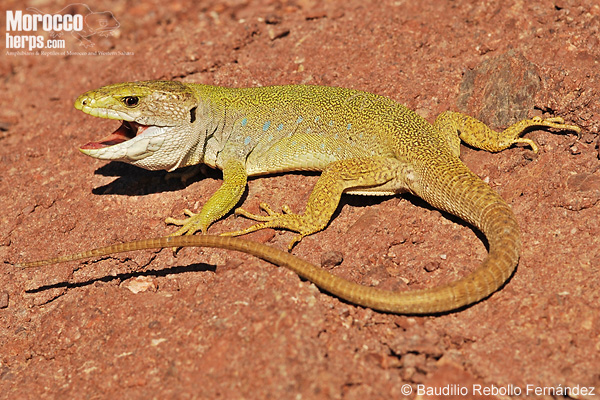
Ocellated lizard (Timon tingitanus). Tiz´n´Test. Photo: © Baudilio Rebollo Fernández.
Some Dotted grainy Frog (Discolglossus scovazzi), Mauritanian toads (Amietoprhynus mauritanicus) and North African Green Toads (Bufotes boulengeri).
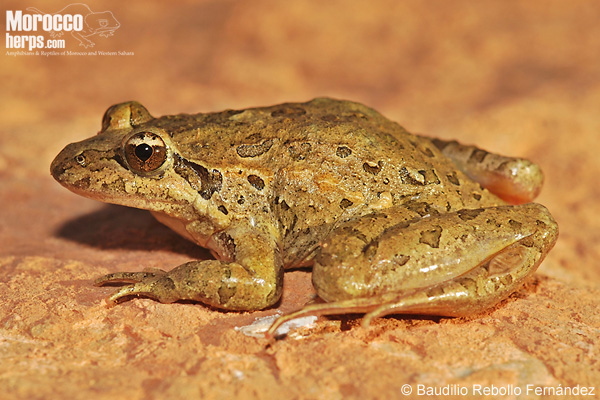
Dotted grainy Frog (Discoglossus scovazii). Photo: © Baudilio Rebollo Fernández.
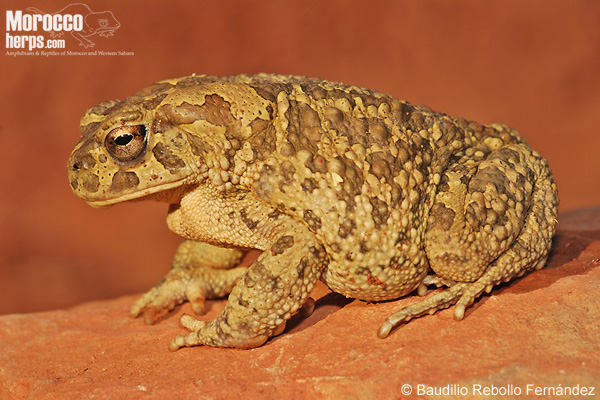
Mauritanian Toad (Amietoprhynus mauritanicus). Photo: © Baudilio Rebollo Fernández.
Early on June the 20th we arrived in Marrakesh, in order to have some time to rest before picking up Luis at the airport. And so we did, we had a rest to charge batteries for the following days of our trip.
On June the 21st 2013, at 10 o´clock we picked up Luis Montero, and once again we decided to go to the south- this time away from the coastal lands- giving a last try to the Guelmin area, as this day was much hotter than the previous days when Javier and I passed by.
On our way we found Morocco Lizard-fingered Gecko (Saurodactylus brosseti), Bibron´s Agama (Agama impalearis), Bosc’s Fringe-toed lizard (Acanthodactylus busacki) and Mediterranean Turtle (Mauremys leprosa).
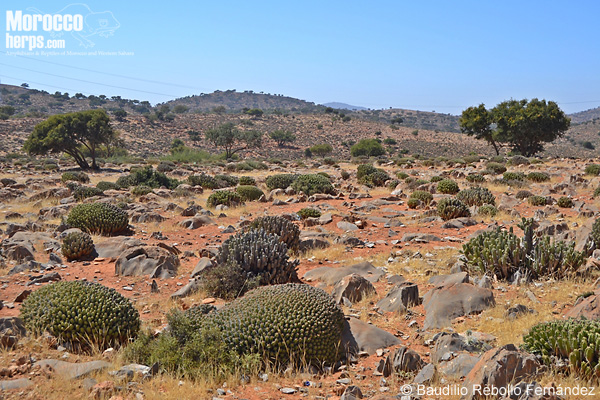
Guelmim surroundings. Photo: © Baudilio Rebollo Fernández.
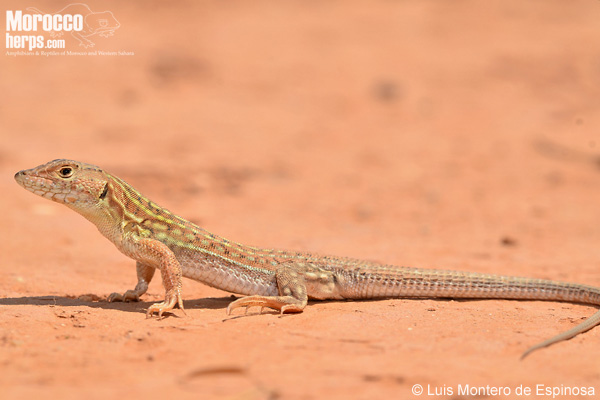
Bosc’s Fringe-toed lizard (Acanthodactylus busacki). Photo: © Luis Montero de Espinosa.
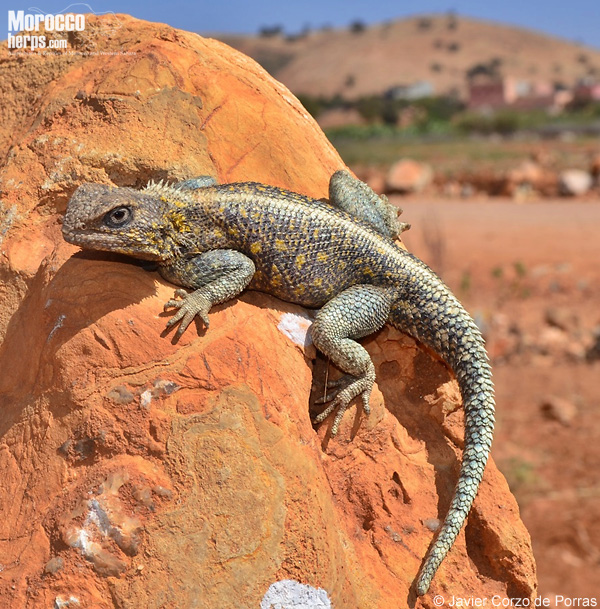
Bibron´s Agama (Agama impalearis). Guelmim. Photo: © Javier Corzo de Porras.
At the Guelmin area, the climate started to be cloudy and windy, though softer than during the previous days (temperatures around 28º C), so we decided to stay one more night in order to search specimens again.
At nightfall we found some Helmethead Geckos (Tarentola chazaliae), and later on that night we found a Northern Elegant Gecko (Stenodactylus mauritanicus).
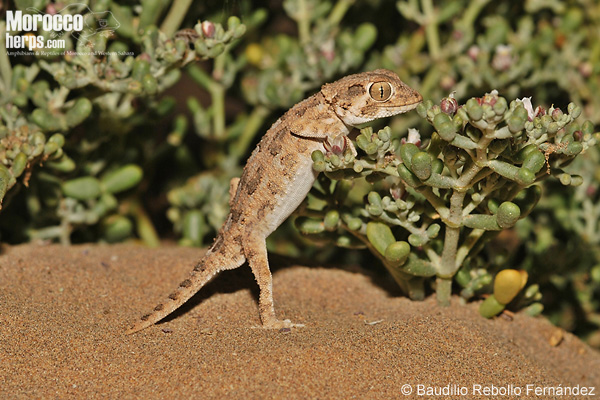
Helmethead Gecko (Tarentola chazaliae) climbing onto a plant, a behavior we observed several times.
Guelmim. Photo: © Baudilio Rebollo Fernández.
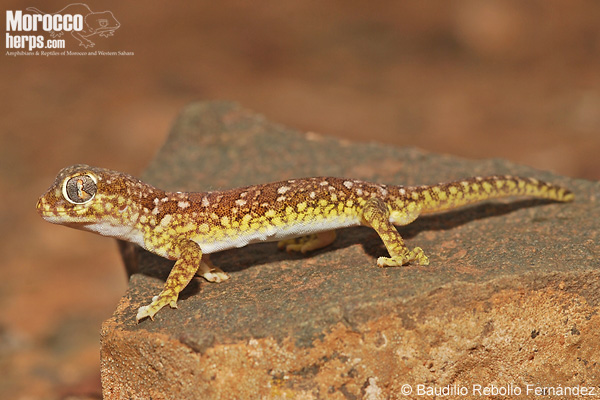
Northern Elegant Gecko (Stenodactylus mauritanicus). Guelmim. Photo: © Baudilio Rebollo Fernández.
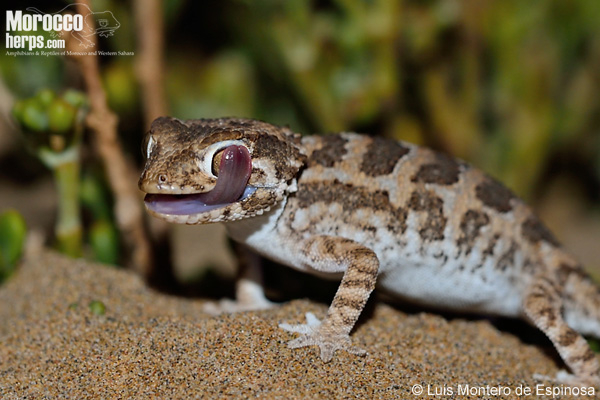
Helmethead Gecko (Tarentola chazaliae) cleaning its eyes. Photo: © Luis Montero de Espinosa.
Suddenly it started to rain and temperature raised up to 20ºC. After several hours of searching we found two great-sized Puff Adders (Bitis arietans) late at night.
It was quite an amazing situation as Puffs were of a great size and as it Spanish name defines it, it snorts (“Bufar”) quite loudly when it feels it is threatened, getting a defiant position as a protection when it feels threatened.
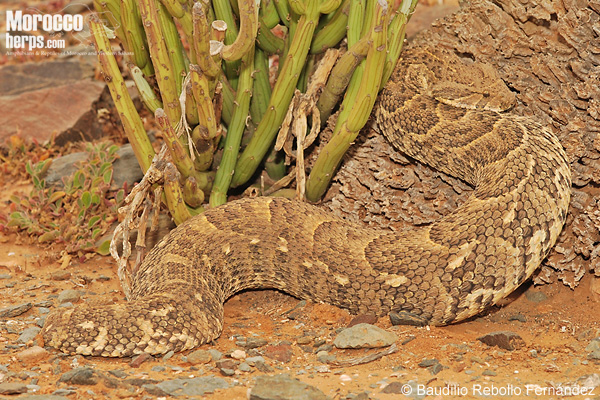
First specimen of a great-sized Puff Adder (Bitis arietans). We can observe its great mimicry with its habitat. Guelmim.
Photo: © Baudilio Rebollo Fernández.
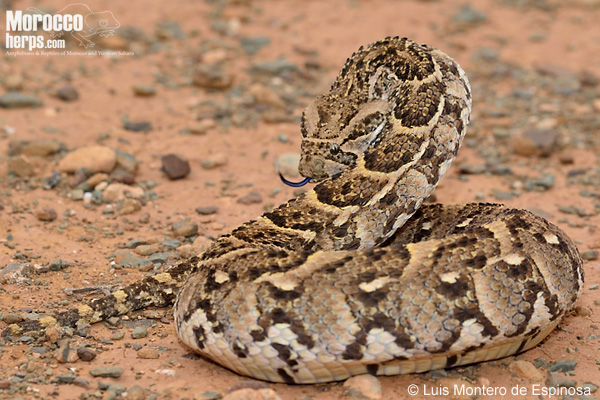
Second specimen of Puff Adder (Bitis arietans) found in a defensive position. Photo: © Luis Montero de Espinosa.
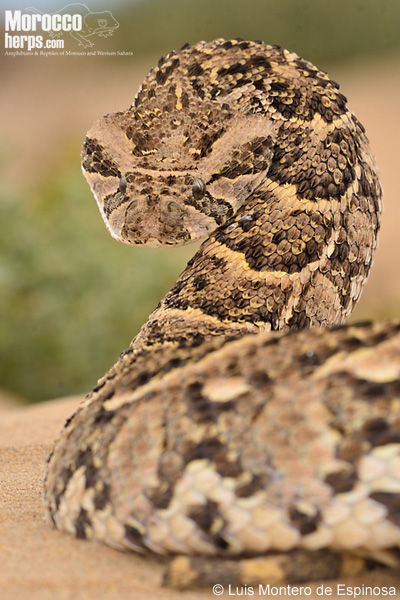
Second specimen of Puff Adder Bitis arietans. Photo: © Luis Montero de Espinosa.
The following day we started going into mainland, towards Assa area. As we were getting into mainland and leaving the coast behind us, the temperature raised quite a lot.
During the day in the Assa area we found quite interesting specimens as Schokari Sand Racer or Bucerrig (Psammophis schockari), Bibron´s Agama (Agama impalearis), Algerian Sand Gecko (Tropiocolotes algericus), Moroccan Spiny-tailed Lizard (Uromastyx nigriventris). It was during the night that we found some specimens of Böhme’s Gecko (Tarentola boehmei), Northern Elegant Gecko (Stenodactylus mauritanicus) and the most interesting specimen, the Roman’s Saw-scaled Viper (Echis pyramidum leucogaster), which provoked us a great euphoria being our star specimen that night.
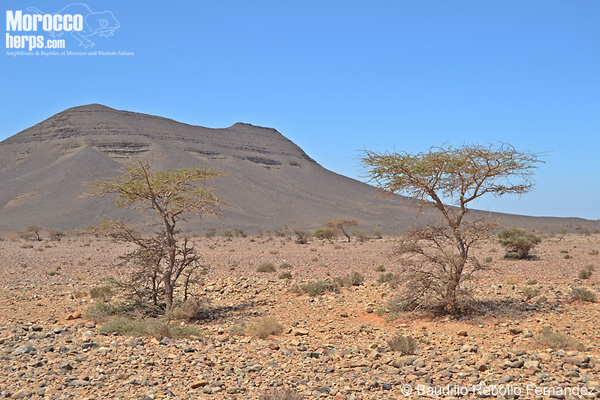
Habitat in Assa. Photo: © Baudilio Rebollo Fernández.
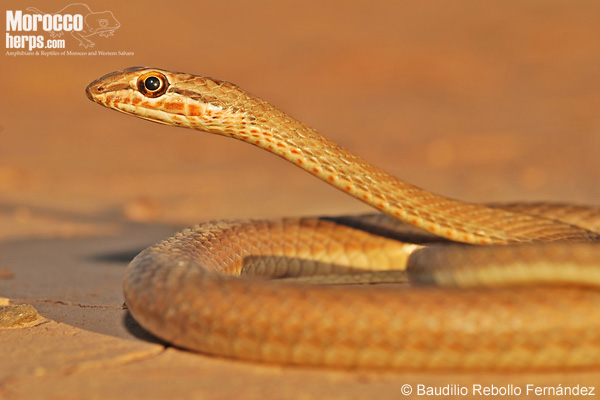
Bucerrig (Psammophis schockari). Assa. Photo: © Baudilio Rebollo Fernández.
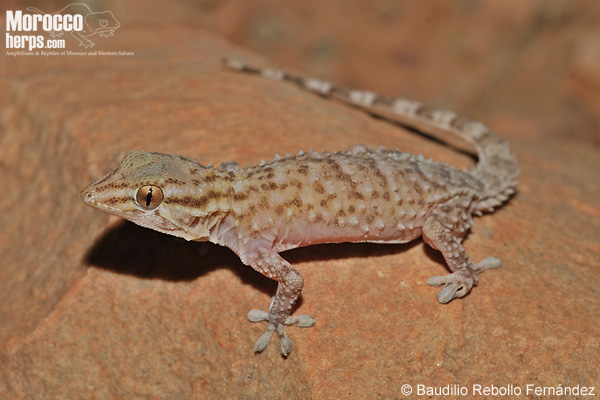
Böhme´s Gecko (Tarentola boehmei). Aouinet Torkoz. Photo: © Baudilio Rebollo Fernández.
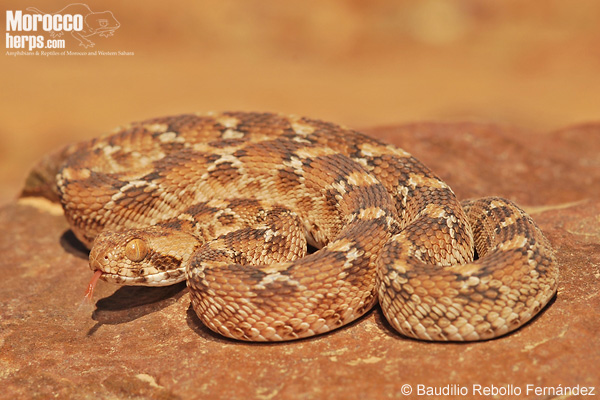
Roman’s Saw-scaled Viper or Echis pyramidum leucogaster, one of the most unknown vipers in Morocco.
Aouinet Torkoz. Photo: © Baudilio Rebollo Fernández.
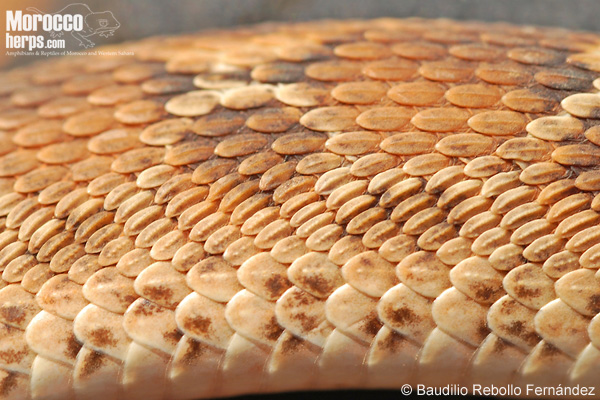
Detailed scales of Echis pyramidum leucogaster,
where sawn scales can be differentiated and used by the viper to make a sound and prevent predators.
Photo: © Baudilio Rebollo Fernández.
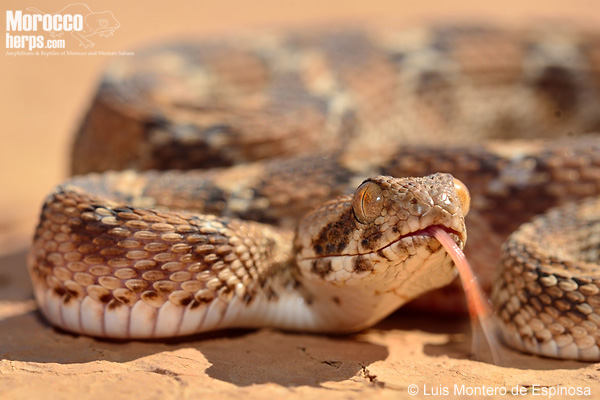
Roman’s Saw-scaled Viper or Echis pyramidum leucogaster, one of the most unknown vipers in Morocco.
Aouinet Torkoz. Photo: © Luis Montero de Espinosa.
After our joy of the night before, we went to Tata, where we had the hottest day of our trip, with temperatures of 48ºC, a sign of a minimal activity for amphibians. We only found a quite active Böhme’s Agama (Trapelus boehmei) under 42ºC temperatures.
We also found some active specimens of Moroccan Spiny-tailed Lizard (Uromastyx), and Bibron´s Agama (Agama impalearis).
As we were arriving to Tata and the sun was setting we found some specimens of Viperine Snake (Natrix maura), and at night time we found some North African Green Toads. As we got closer to Oued, we heard some Mauritanian Toads and Stripeless tree Frogs. We also found another type of Gecko, the Oudri’s Fan-footed Gecko (Ptyodactylus oudrii).
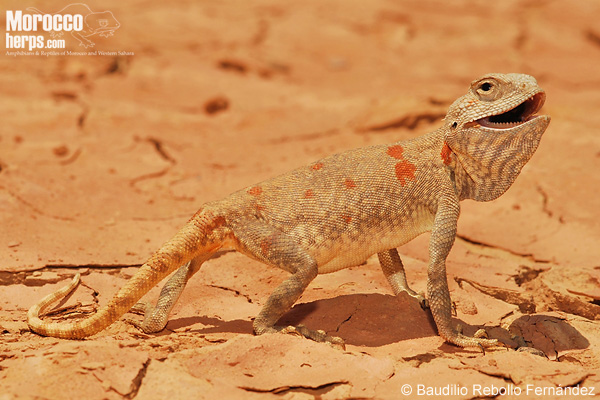
Böhme’s Agama (Trapelus boehmei). Assa. Photo: © Baudilio Rebollo Fernández.
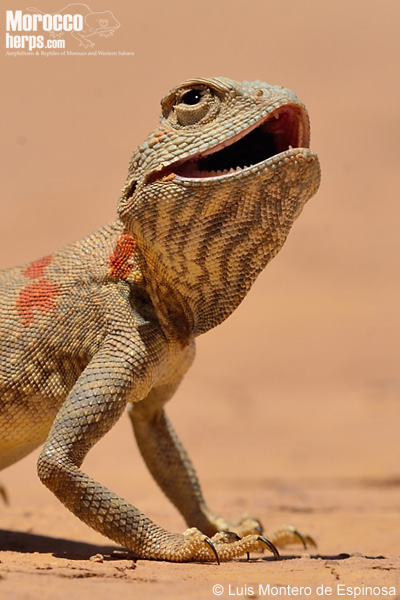
Detailed Böhme’s Agama. Assa. Photo: © Luis Montero de Espinosa.
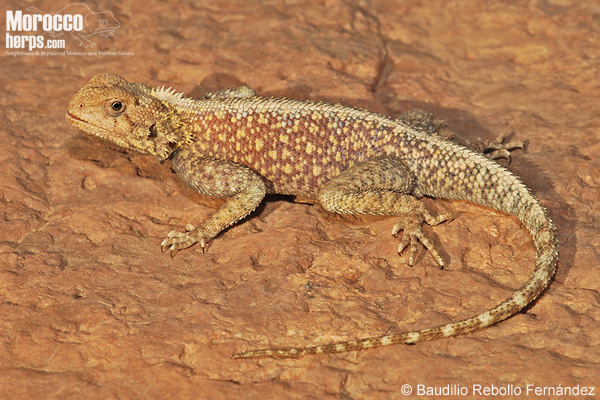
Bibron´s Agama (Agama impalearis). Assa. Photo: © Baudilio Rebollo Fernández.
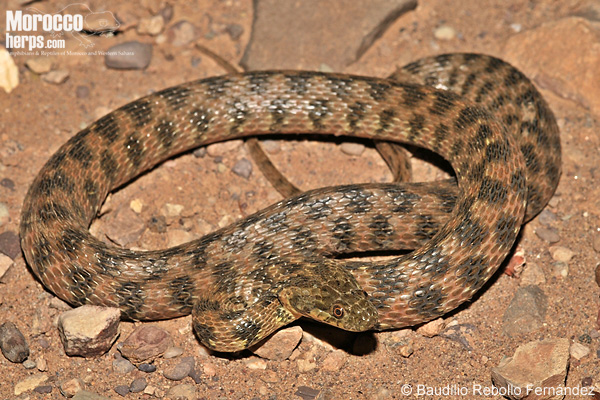
Viperine Snake (Natrix maura). Tata. Photo: © Baudilio Rebollo Fernández.
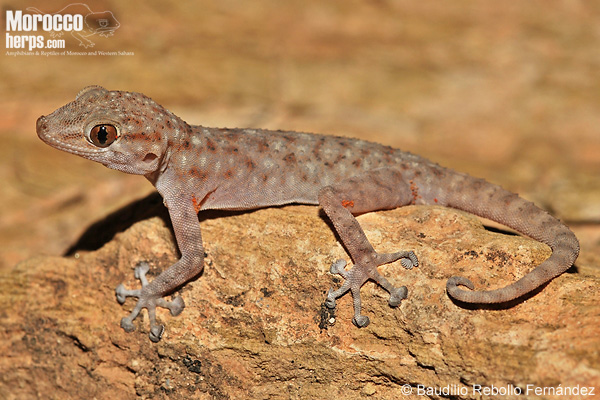
Oudri’s fan-footed gecko (Ptyodactylus oudrii). Tata. Photo: © Baudilio Rebollo Fernández.
Our following target point was Mhamid where we drove all June 24th, to get there at a time when we could do some searching before the night fell. Also, we did some searching next day.
During our way we stopped only a few times and we saw some Bibron´s Agama sunbathing on rocks and stones and Acanthodactylus sp. Near the road we found a small pit where we saw some Stripeless Frogs with a grayish color.
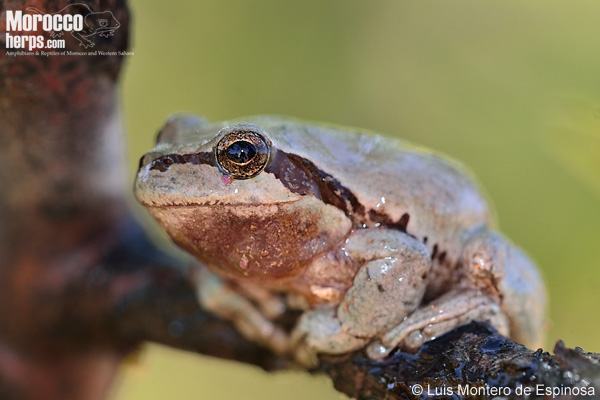
Stripeless tree frog (Hyla meridionalis). Photo: © Luis Montero de Espinosa.
We got there at night fall and we started to search around and we found some Dwarf Sand Gecko (Stenodactylus petrii) and two Sahara Sand Vipers (Cerastes vipera) an adult and a young one.
Vipers around this area are different in color from the Sahara Sand Vipers (Cerastes vipera) in the coastal area near Tarfaya, as I observed last year. These vipers have a more uniform and reddish color, with marked black dots, but less contrasted than the coastal ones, which helps them to mimicry in the sand.
The adult specimen has the last end of its tail quite yellow colored and it moves it like a worm. This behavior is known as “Caudal luring” and it’s mainly used to attire animals in order to hunt them and also when viper feels menaced, they use it to misguide the animal.
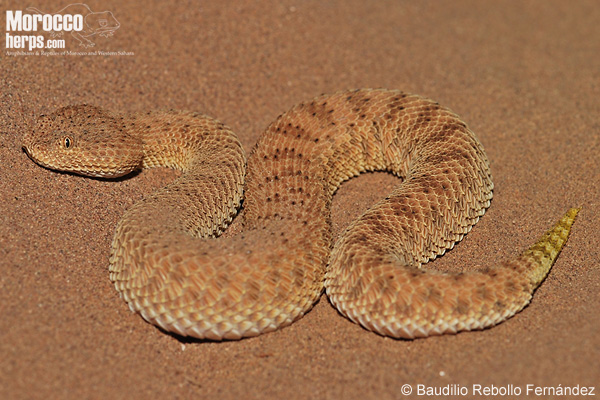
Adult specimen of Sahara Sand Viper (Cerastes vipera). We can perfectly observe the intense yellow color of its tail, which moved as a bait is used to capture its preys, while viper is hidden under the sand. This behavior is known as “Caudal luring”. Mhamid. Photo: © Baudilio Rebollo Fernández.
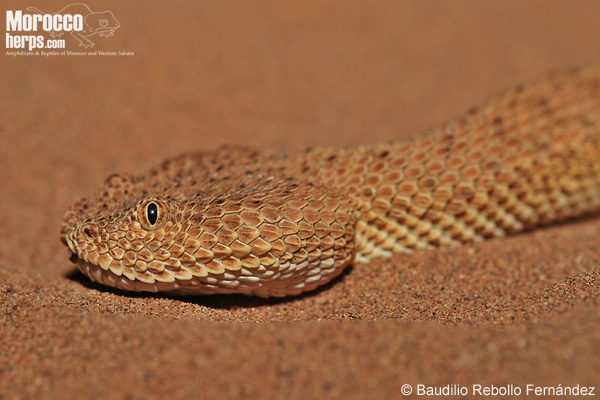
Sahara Sand Viper (Cerastes vipera) detailed head. Photo: © Baudilio Rebollo Fernández.
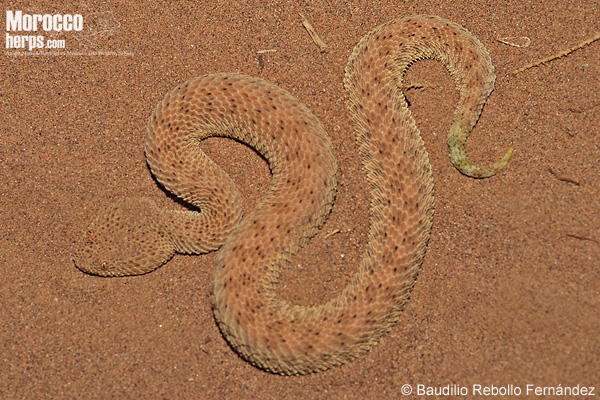
Sub-adult specimen of Sahara Sand Viper (Cerastes vipera). Mhamid. Photo: © Baudilio Rebollo Fernández.
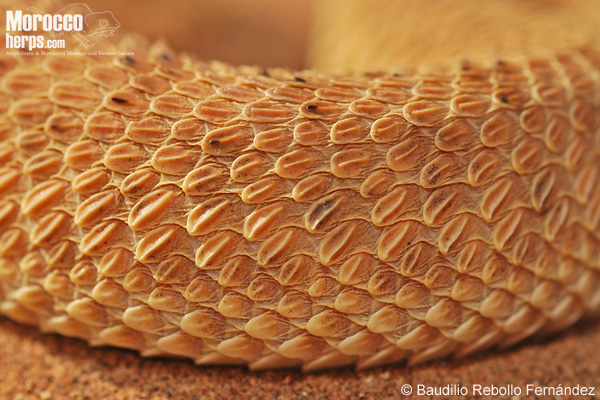
Sahara Sand Viper (Cerastes vipera) scales detail.
We can observe its sawn scales which make a preventive sound when they touch their predators.
Photo: © Baudilio Rebollo Fernández.
After our success in Mhamid, we decided to go to Merzouga, to walk around its wondrous sea of dunes, searching some other amphibians as well as some rest for us.
During the first night there we went around searching some specimens on the enormous dunes but activity was quite poor at that moment. There was some activity around bushes, but mainly there were rodents and some beetles around the dromedary feces.
We could see some Dwarf Sand Geckos (Stenodactylus petrii) and nothing else.
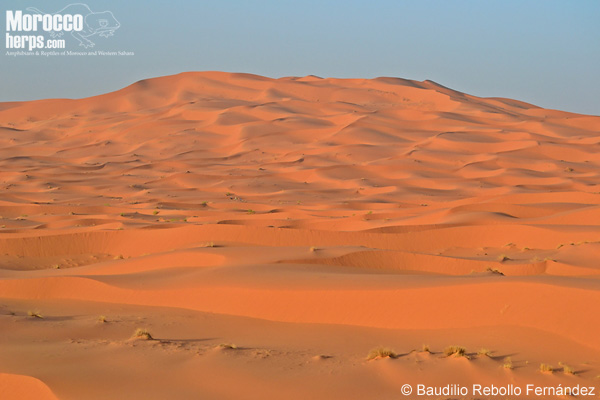
Merzouga dunes. Photo: © Baudilio Rebollo Fernández.
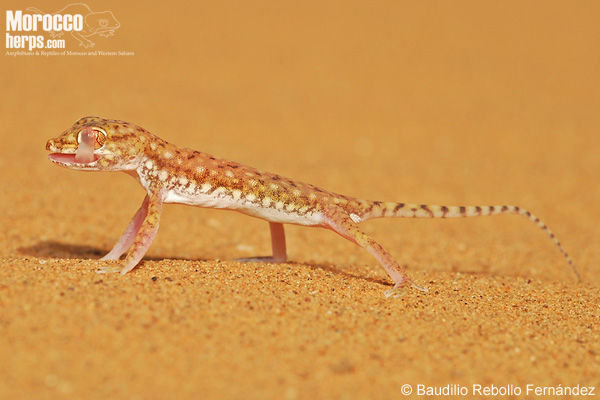
Dwarf Sand Gecko (Stenodactylus petrii) cleaning its eyes. Photo: © Baudilio Rebollo Fernández.
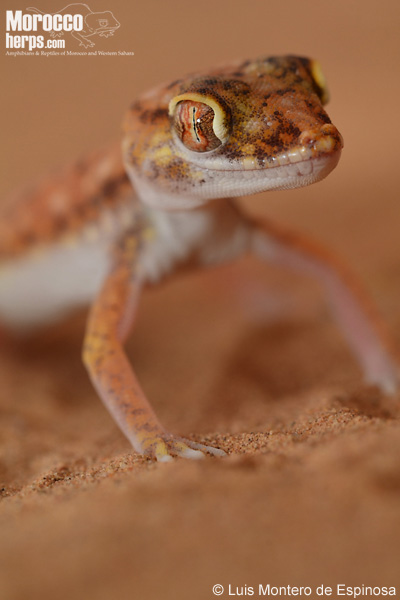
Dwarf Sand Gecko (Stenodactylus petrii) in detail.
Photo: © Luis Montero de Espinosa.
After a while, I met a Berber and asked him about the conditions of the dunes, and I mean conditions because after the abundance of people and four wheel vehicles, which use to enjoy themselves at that time of the year, which happen to meet in the highest point of activity of animals as Saharan lizard skink (Scincus albifasciatus) or Sahara Sand Viper (Cerastes vipera) and I wanted to know how the number had decreased.
The man in his 50´s, after asking me what I was looking for at night time told me: “…this afternoon I freed one of them over here, the tracks might be around here…”, and yes, there they were the tracks of this Scincus, but it was impossible to track it or find it even with his help.
Later, he told me that during all their lives they had eaten Saharan lizard skinks, as the dunes were their “sea” and this Scincus their “sardines”. They had barbecues and they ate even 50 or more of these lizards…
Nowadays, he said: “that they did not see many of them, nor vipers, though the last ones can be seen on the path the dromedaries draw and do their feces, so then the rodents go to eat them and vipers capture them at sun rise”, this is how he related it.
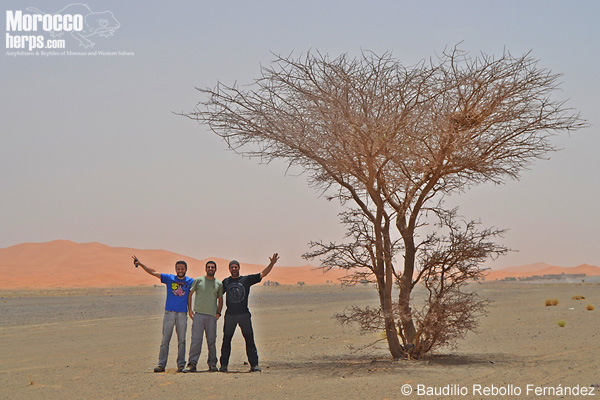
From left to right, Javier, Luis and Budi. Photo: © Baudilio Rebollo Fernández.
Early next morning, I went to take some pictures of a Stenodactylus petrii; while doing it I saw how a Northern Wheather observed me from the top of a tower, and I had hardly taken two or three pictures that I saw through my camera how the Gecko disappeared in the beak of the bird bringing its prey to the top of the tower. After a while I went up the tower and I saw the Northern Wheather and the Gecko, the wheather was attacking but the Gecko was getting on quite well. I went down to take the camera to picture this behavior and when I went up again, the Gecko was still there and the Northern Wheather was cleaning its beak from a further distance already, and then it left flying.
I do not know if it flew away because of me, but I must say that since it captured the Gecko until it flew away some 15 minutes passed and it was not able to eat it, and I could not understand that very well, it is still a doubt in my mind…
Later this day we took some time to rest and I went a little more southern from Merzouga heading Taouz, searching another interesting habitats. Then we went up the highest dune where we found some Acanthodactylus sp., which we were not able to identify.
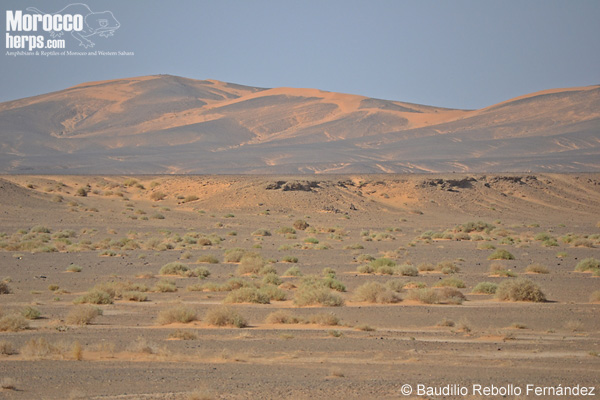
Habitat near Taouz. Photo: © Baudilio Rebollo Fernández.
Next day, June 27th, we took direction to Bouarfa, looking for other specimens not seen in this expedition yet. On our way, we found a Moila Snake (Rhagerhis moilensis) and an Acanthodactylus Death on road and also a Böhme’s Agama (Trapelus boehmei).
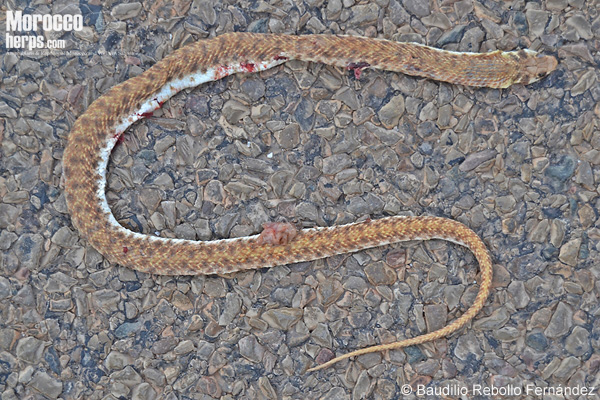
Run over Moila Snake (Rhagerhis moilensis). Photo: © Baudilio Rebollo Fernández.
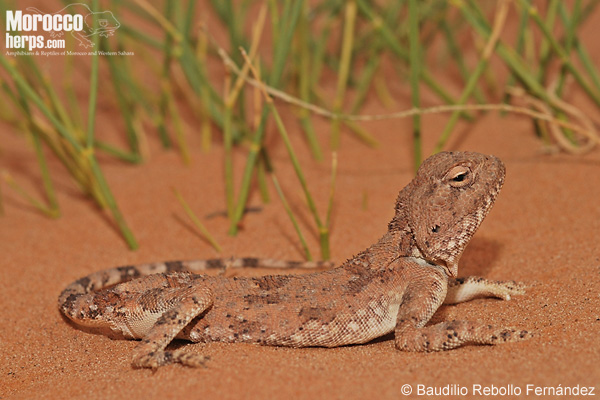
Böhme’s Agama (Trapelus boehmei). Bouarfa. Photo: © Baudilio Rebollo Fernández.
As we approached Bouarfa the weather started to get worse, cloudy and stormy, with no rain and quite hot temperature. We could see a Northern Elegant Gecko (Stenodactylus mauritanicus) and a great- sized Mograbin Diadem Snake (Spalerosophis dolichospilus) quite active at the last hours of the day, and still the best was to arrive.
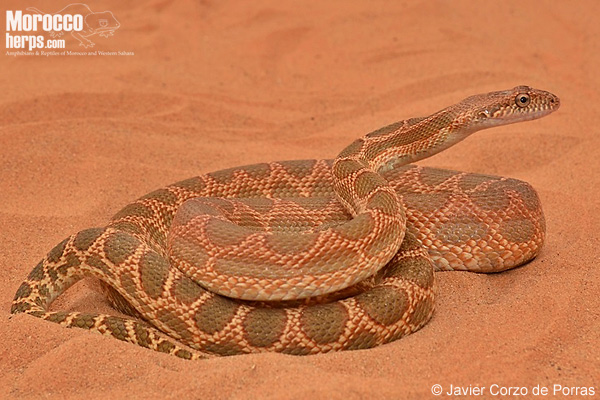
Great-sized Mograbin Diadem Snake (Spalerosophis dolichospilus). Bouarfa. Photo: © Javier Corzo de Porras.
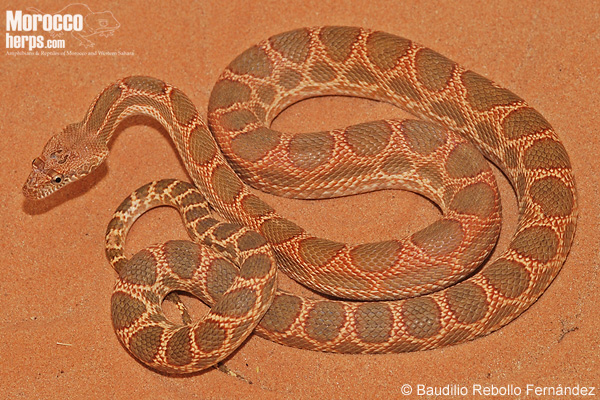
Great-sized Mograbin Diadem Snake (Spalerosophis dolichospilus) which design can be well observed. Bouarfa.
Photo: © Baudilio Rebollo Fernández.
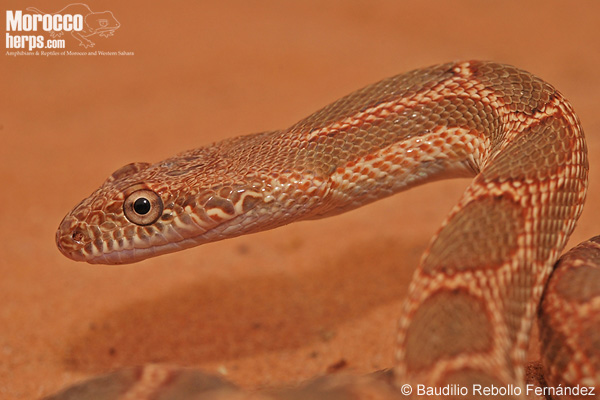
Great-sized Mograbin Diadem Snake (Spalerosophis dolichospilus) in detail. Bouarfa.
Photo: © Baudilio Rebollo Fernández.
We explored the area where we saw many Desert Wall Geckos (Tarentola deserti), which are specimens of great size on this area. Soon after that our first Horned Viper (Cerastes cerastes), but what we did not know is that we saw up to 11 vipers and we stopped even though we knew we would find more if we searched. It was like an activity explosion, with some sand storms included and with quite windy conditions, we were able to see the vipers in many different positions, semi buried, hidden, creeping, on the top of rocks…
Here we have added some pictures to see the difference in the designs and variety of the same.
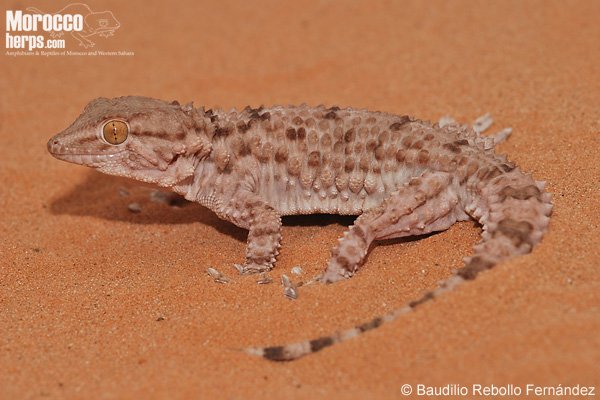
Tarentola deserti. Bouarfa. Photo: © Baudilio Rebollo Fernández.
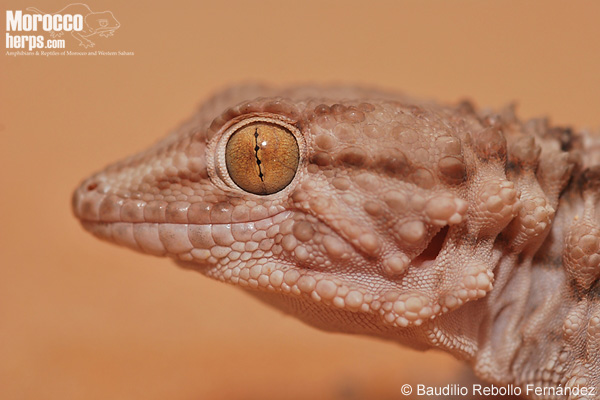
Desert Wall Gecko detailed head (Tarentola deserti). Bouarfa.
Photo: © Baudilio Rebollo Fernández.
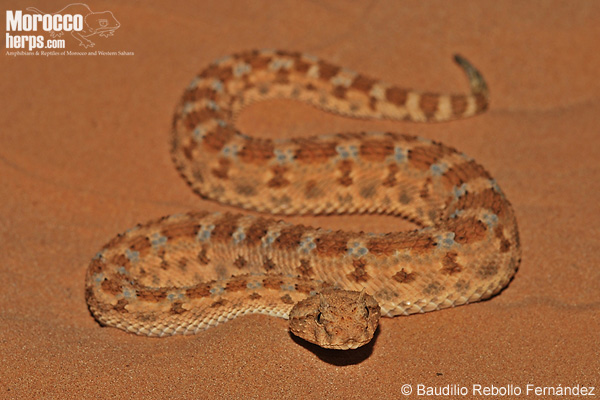
Adult specimen of Horned Viper (Cerastes cerastes). Bouarfa. Photo: © Baudilio Rebollo Fernández.
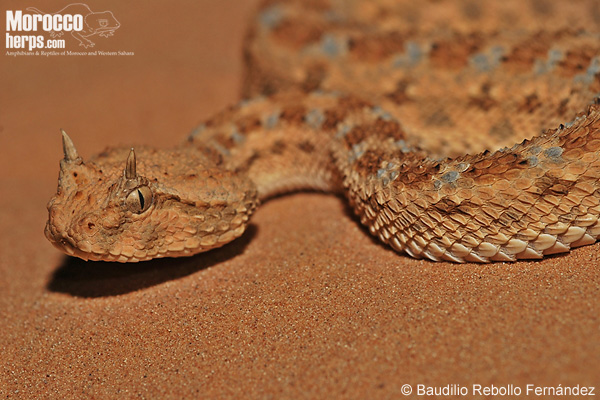
Details of the same specimen of Horned Viper (Cerastes cerastes). Bouarfa. Photo: © Baudilio Rebollo Fernández.
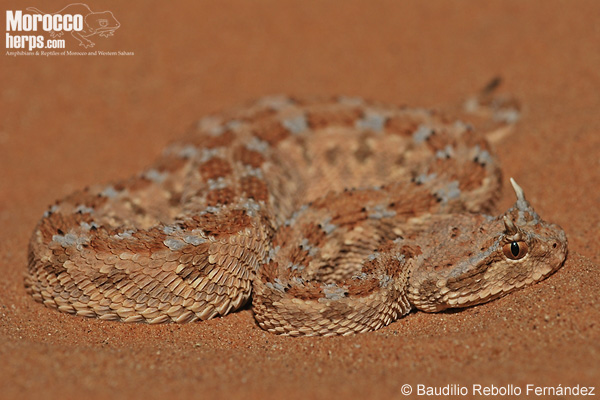
Young specimen of Horned Viper (Cerastes cerastes). Bouarfa. Photo: © Baudilio Rebollo Fernández.
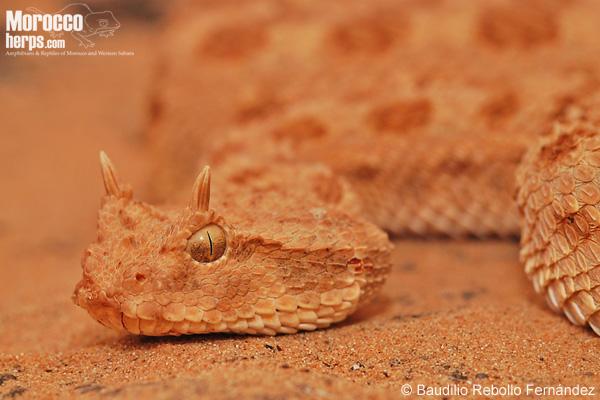
Another adult specimen of Horned Viper (Cerastes cerastes).
Bouarfa. Photo: © Baudilio Rebollo Fernández.
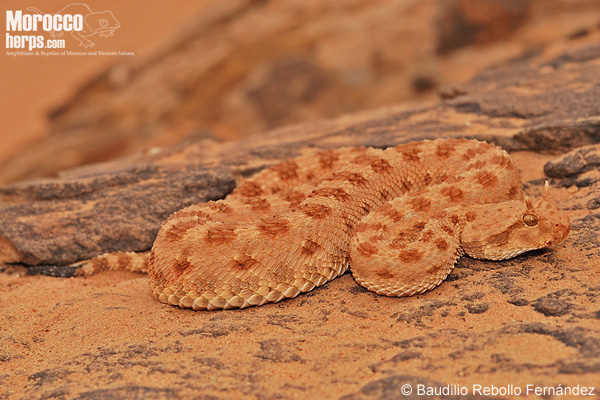
Another adult specimen of Horned Viper (Cerastes cerastes). Bouarfa. Photo: © Baudilio Rebollo Fernández.
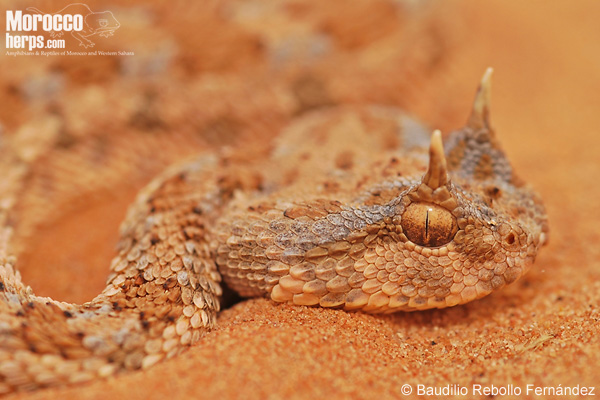
Young specimen of Horned Viper in detail (Cerastes cerastes). Bouarfa. Photo: © Baudilio Rebollo Fernández.
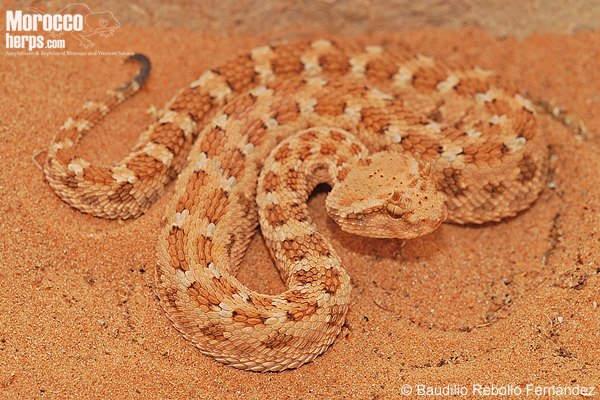
Another semi-adult specimen of Horned Viper (Cerastes cerastes). Bouarfa. Photo: © Baudilio Rebollo Fernández.
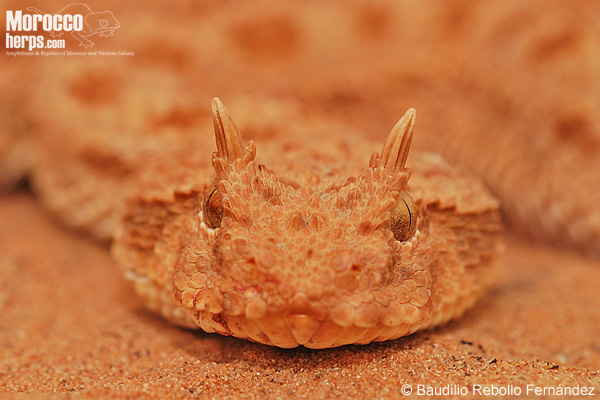
Detail of the penetrating look of this beautiful animal, with horns made by a series of scales that have evolved that way. Horned Viper (Cerastes cerastes). Bouarfa. Photo: © Baudilio Rebollo Fernández.
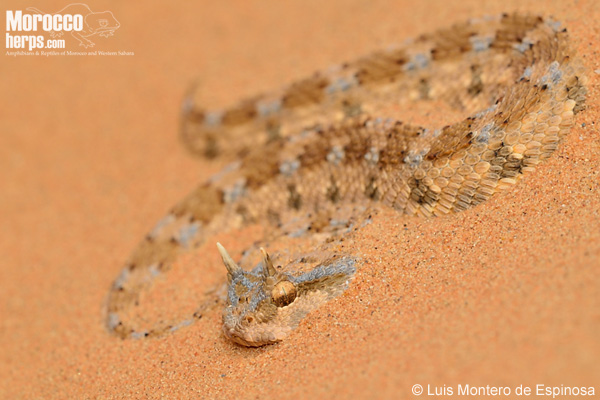
Young specimen of Horned Viper (Cerastes cerastes) half-buried. Photo: © Luis Montero de Espinosa.
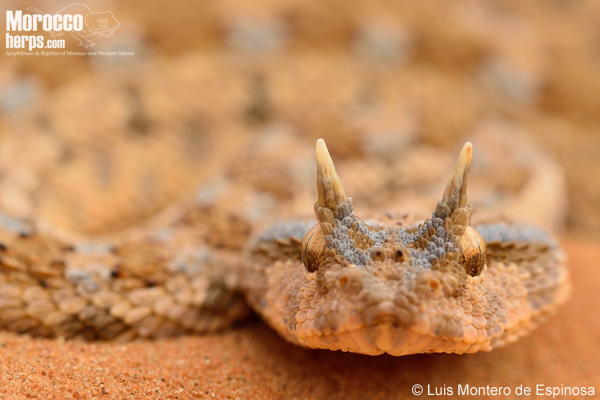
Details of previous specimen. Photo: © Luis Montero de Espinosa.
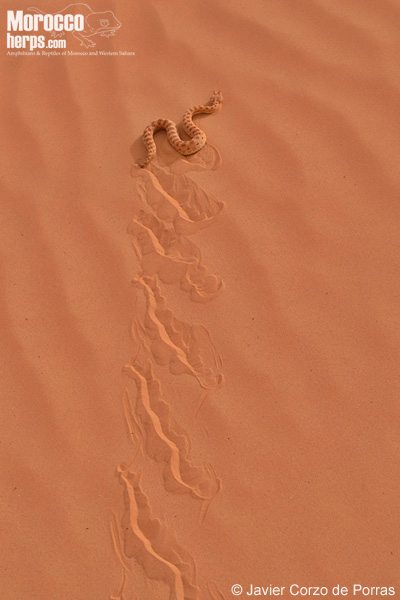
Horned Viper (Cerastes cerastes) and the tracks its leaves behind as it moves on the sand.
Photo: © Javier Corzo de Porras.
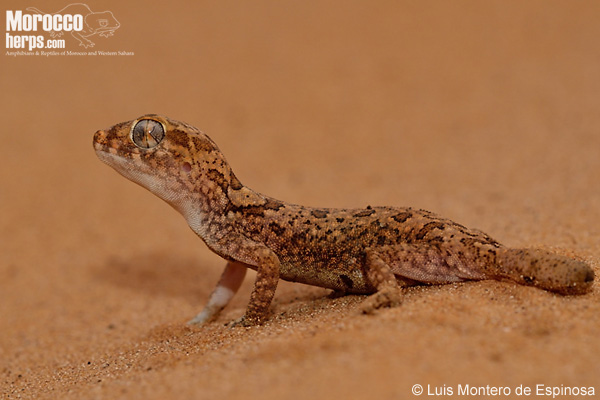
Northern Elegant Gecko (Stenodactylus mauritanicus) with a regenerated tail as can be seen in the picture.
Photo: © Luis Montero de Espinosa.
When we got up the following day, quite early, there was a strong wind to search for amphibians and reptiles, as sand was into our eyes as well as our photograph material could be damaged, so we decided to go back, this was the day to go back to Spain, so we headed for Melilla, without stopping on our way.
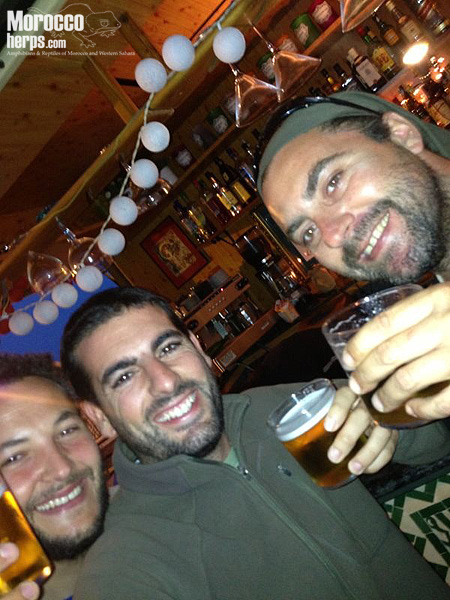
The three members of the expedition celebrating their arrival to Melilla with a cold beer.
At the end of our expedition we did some 7,653 km. since we left until we got home, what we finally did, quite tired but with joy and satisfied by having had the privilege of enjoying all these animals and the beautiful scenery we were surrounded by. I hope you have also enjoyed with the story told herein.
Translated by Carlos Perez Fontán-Membrives.
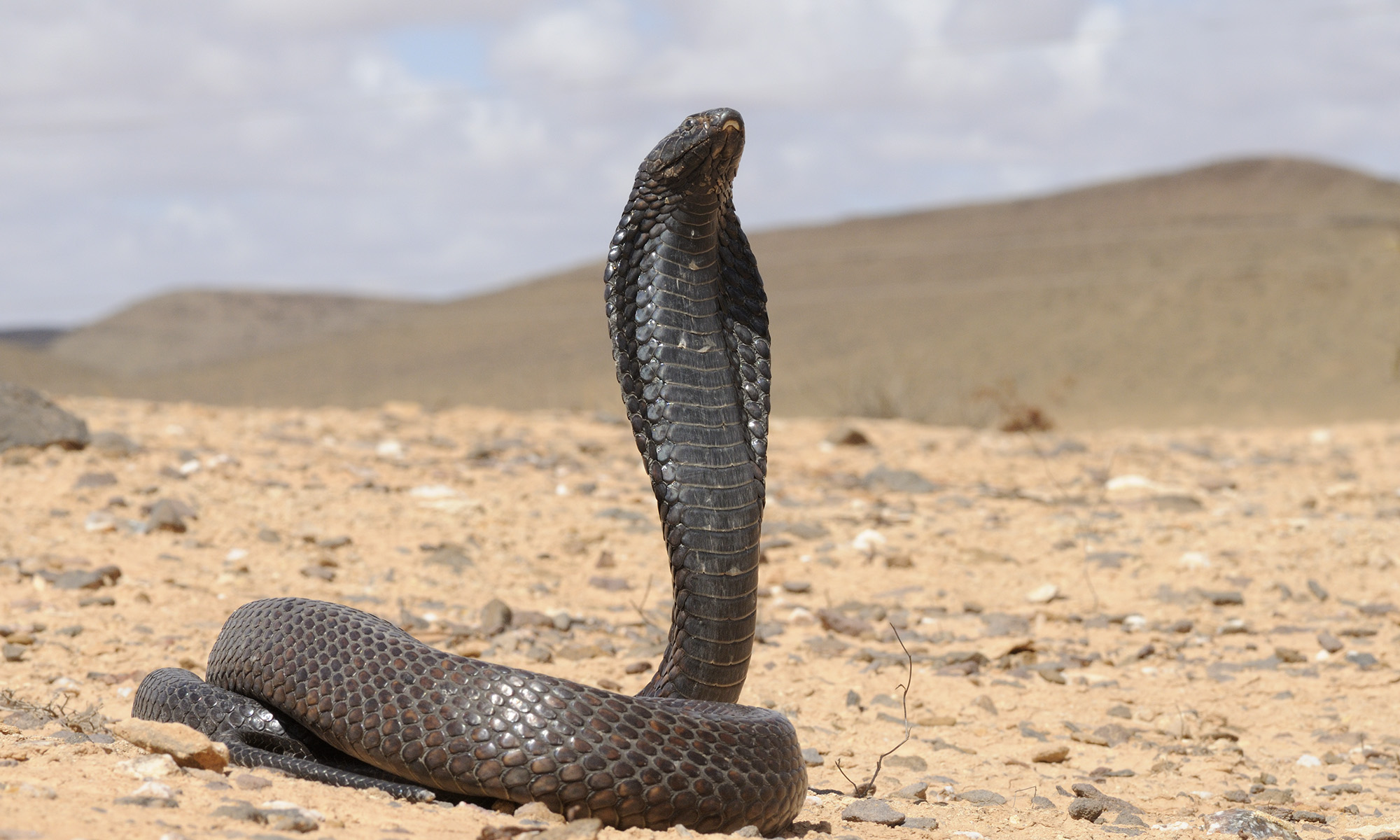
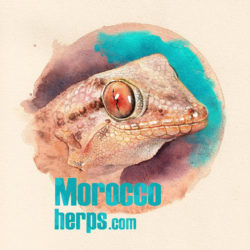
New trip report:
http://t.co/YAxIwRUlMg http://t.co/3IZg9W1Wrl
RT @moroccoherps: New trip report:
http://t.co/YAxIwRUlMg http://t.co/3IZg9W1Wrl
What kind of diamond memories do u have? Check out other people’s experiences…Does it sound familiar? http://t.co/wNEhSMDuE3
Hey Guys!
Awesome finds! Any tips on specific locations where I could fine Bitis arietans, Cerastes vipera and Cerastes cerastes? 😉 You can allways mail me back on this! Probably going for a week pretty soon and I want to see as many species as possible. Primarily aiming on Bitis arietans and Naja haje.
Thanx in advance!
Bryan
Just woowwww, I use to go annually in Morocco mainly for birds but also for herpetology, seen only rarely such nice photos and a succesful trip like this!! Thanks for sharing
Andrea
Thanks for sharing your experiences, it’s wonderful. The pictures of the Trapelus are just incredible. All the best. Alfredo.
Gracias por brindar de una forma tan simple y técnica, vuestra pasión por la naturaleza. Felicidades!!!